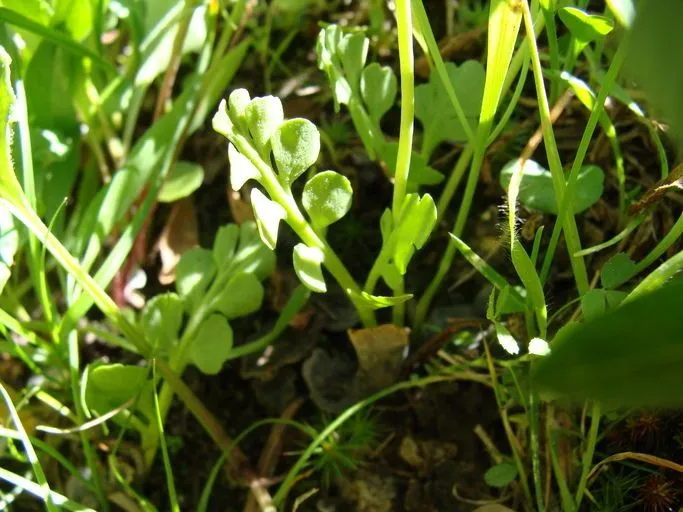
Author: Hitch.
Bibliography: Amer. J. Sci. Arts 6: 103 (1823)
Year: 1823
Status: accepted
Rank: species
Genus: Botrychium
Vegetable: False
Observations: Subarctic & Temp. Northern Hemisphere
The Little grapefern, scientifically known as Botrychium simplex, is an intriguing member of the Ophioglossaceae family. Described in literature as early as 1823 by Hitch., this plant has garnered attention for its unique characteristics and widespread presence in various regions.
Botrychium simplex thrives primarily in the subarctic and temperate zones of the Northern Hemisphere, making it a common sight in these areas. This distribution highlights the plant’s adaptability to different climatic conditions, often growing in moist and shaded environments, such as forest floors and grassy slopes.
The Little grapefern is recognized for its modest stature and distinctive appearance. Unlike many other ferns, the Botrychium simplex has a more simplified structure. It features a single, small frond that tends to emerge early in the growing season, often observed in conjunction with a spore-producing structure which resembles a bunch of tiny grapes, giving it its common name.
The ecological role of Botrychium simplex is crucial, as it contributes to the biodiversity and stability of the ecosystems it inhabits. Its presence is indicative of a healthy environment, often associated with rich soil and minimal disturbance.
Historically, the study and documentation of the Little grapefern reflect the broader interest in botany and plant sciences during the early 19th century. The detailed account provided by Hitch. in the American Journal of Science and Arts stands as a testament to the enduring curiosity and scientific rigor of that era, shedding light on the diverse plant life that populates our world.
In summary, Botrychium simplex is a small yet significant fern with a wide range in the Northern Hemisphere, especially in subarctic and temperate zones. Its unique morphology and ecological importance make it a fascinating subject for both botanists and nature enthusiasts alike.
Ita: botrichio minore
Nor: dvergmarinøkkel
Swe: dvärglåsbräken
Deu: einfacher rautenfarn
Dan: enkelt månerude
Eng: least moonwort, little grapefern
Fra: petit botrychium, botryche simple
Lav: vienkarša kekarpaparde
En: Little grapefern, Dwarf grape-fern, Least moonwort, Simple grape-fern, Simple moonwort, Small grapefern
Be: Граздоўнік просты
Cs: Vratička jednoduchá
Da: Enkelt månerude
Nl: Kleine maanvaren
Et: Liht-võtmehein
Fi: Pikkunoidanlukko
Fr: Petit botrychium, Botryche simple
De: Einfache Mondraute, Einfacher Rautenfarn, Einfacher Traubenfarn
Is: Dvergtungljurt
It: Botrichio minore
Lv: Vienkarša kekarpaparde
Lt: Mažasis varpenis
No: Dvergmarinøkkel
Pl: Podejźrzon pojedynczy
Ru: Гроздовник простой
Sv: Dvärglåsbräken
Taken Jan 1, 1900 by EOL − Encyclopedia of Life (cc-by-nc)
Taken May 20, 2019 by Nancy Schiano (cc-by-sa)
Taken Aug 12, 2012 by EOL − Belinda Lo (cc-by-nc-sa)
Taken Aug 2, 2019 by Brett Bissell someguy (cc-by-sa)
Taken Mar 28, 2022 by Aryd’ell Hotelling (cc-by-sa)
Taken Aug 12, 2012 by EOL − Belinda Lo (cc-by-nc-sa)
Taken Aug 12, 2012 by EOL − Belinda Lo (cc-by-nc-sa)
Taken Jan 1, 1900 by EOL − Encyclopedia of Life (cc-by-nc)
Taken Jan 1, 1900 by EOL − Encyclopedia of Life (cc-by-nc)
Taken Jan 1, 1900 by EOL − Encyclopedia of Life (cc-by-nc)
Taken Jan 1, 1900 by EOL − Encyclopedia of Life (cc-by-nc)
Taken Aug 12, 2012 by EOL − Belinda Lo (cc-by-nc-sa)
© copyright of the Board of Trustees of the Royal Botanic Gardens, Kew.
Growth habit>: Forb/herb
Ph maximum: 4.0
Ph minimum: 3.0
Light: 6
Atmospheric humidity: 5
Soil nutriments: 2
Family: Myrtaceae Author: (F.Muell.) K.D.Hill & L.A.S.Johnson Bibliography: Telopea 6: 402 (1995) Year: 1995 Status:…
Family: Rubiaceae Author: Pierre ex A.Froehner Bibliography: Notizbl. Bot. Gart. Berlin-Dahlem 1: 237 (1897) Year:…
Family: Sapindaceae Author: Koidz. Bibliography: J. Coll. Sci. Imp. Univ. Tokyo 32(1): 38 (1911) Year:…
Family: Asteraceae Author: A.Gray Bibliography: Pacif. Railr. Rep.: 107 (1857) Year: 1857 Status: accepted Rank:…
Family: Fabaceae Author: Medik. Bibliography: Vorles. Churpfälz. Phys.-Ökon. Ges. 2: 398 (1787) Year: 1787 Status:…
Family: Aspleniaceae Author: (Cav.) Alston Bibliography: Bull. Misc. Inform. Kew 1932: 309 (1932) Year: 1932…